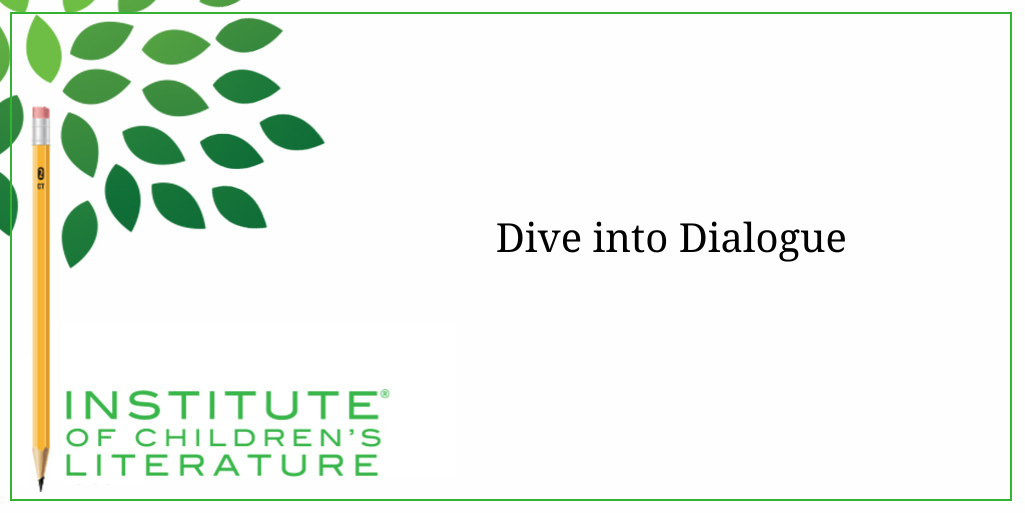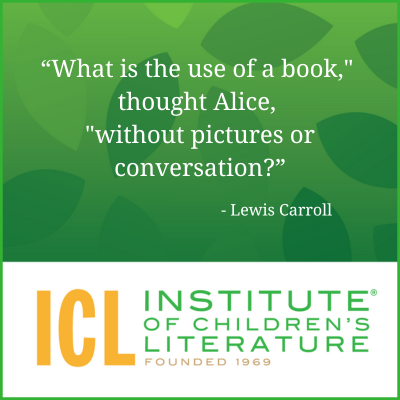
5 Ways Writers Can Prep for 2025 Goal Setting
Before we roll on to the new writing year, let’s harness our optimism for the blank slate before us and prepare for our 2025 Goal Setting just for writers.

Dialogue is many writers’ favorite part of a story. It’s many readers’ favorite part too. Dialogue makes your character very present and real in a scene. It’s engaging. It also involves frequent paragraph breaks and thus offers white space on the page, which is restful for young readers (and old readers too, if I’m honest). It is often the place where humor and wit emerge in writing. Taken all together, this means dialogue is important and important to get right.
 In and Out
In and OutGreat dialogue tends to be tightly written. Readers have increasingly short attention spans. This is true at every age level, including adults. We have so much competition for our attention. We must keep that in mind as we write. If we pen long, slow, information-dumping dialogue, readers will skim it, skip it, or forget it. And since information dumping is normally about feeding readers story bits they need, it can make a story confusing if the information is presented in a way readers cannot receive.
All of that means dialogue needs to be short and sweet. Consider what the point of the conversation is intended to be and then accomplish it with a minimum of rambling or pontificating. Keep in mind that in a big block of text, readers will remember the beginning of it and the end of it, but much of the stuff in the middle will be lost to the reader. This is why readers (and even editors) can get confused about important information offered in the center of one of these big clumps. If a reader truly needs this info for the story to make sense, then make it pithy and isolate it. For instance, if you need to tell the reader that the character was born in Ireland, this conversation would be bad:
He smiled over the mug of cocoa. “If this were a movie, this would be the spot where I’d ask you to tell me about yourself.”
She laughed, though it felt forced. “Well, my parents dragged me to this ski resort because they think I spend too much time gaming on my computer. I’m hopeless at games though, as much as I love them. I blame my parents for that hopeless part. They have all these rules about screen time. It’s been that way since I was a baby in Ireland and toddled over to play Minesweeper on Dad’s laptop. So I try to cram as many zombie games as I can in the two hours after I finish homework and the moment I’m commanded to go to bed. They don’t understand that streaming games could be a career, but I have to have time to do it.”

Dialogue blobbing can come about because readers want to convey specific things like the sense that someone is babbling or perhaps that someone has a very dry, academic voice. That is a valid reason. But when you’re giving those kinds of dialogue blobs, be sure there is nothing in the dialogue that is vital for the reader to remember (unless it’s a clue in a mystery and you want the reader to miss it). Even then, don’t do it often, and be aware that the actual blobbed dialogue is not going to be retained by most readers, so when doing it for effect, go for the effect, knowing the content will be lost.
Dialogue does a lot for a story. It does a lot of narrative nonfiction too—and direct quotes (as long as they’re interesting) also add engagement to other forms of nonfiction. First, it reveals personality. In fiction, it’s an opportunity to show the character’s emotions, voice, and motivations through how that character speaks, especially to other characters. Dialogue shows relationships and reactions to other characters.
Think a moment about conveying emotion through dialogue. Suppose one character has just been introduced to another. Think about different ways a character might react to that and what emotions it could reveal.

Now what about if someone reacted to an introduction like this:
“Yeah, so?” He huffed. “I got things to do.” He turned and walked away, leaving Jesse with his hand stuck out in the air as if he were waiting for a bird to land on it.
We would imagine very different emotions in play in each of these tiny snippets. But I didn’t label emotions. I didn’t state them outright. I simply used dialogue and the physical actions surrounding it to imply emotions. I left the interpretation up to the reader.
As much as info dumping is bad, dialogue is useful when one character needs to reveal information to another character (and thus to the reader.) The key to doing it right is to make it logical that this person at this time would share this information. Generally, you want to avoid remember-the-time dialogue. That happens when a character pointedly tells another character something the second person already knows simply so the reader can hear it too.
You sometimes have to do this, but it should be the very last of your last-resort dialogue choices (unless you’re creating a character who annoyingly is constantly bringing up the past for a specific purpose.) For instance, this would be a proper use of remember-the-time dialogue.

In a bit like that, the whole point is to bring up something to embarrass Kat. The purpose of that dialogue is less to let the reader know that Kat was once a bedwetter and more to show what sort of person Madison is and to introduce an ongoing problem relationship. If Kat telling something she already knows makes sense in the moment, then it’s okay. We believe that character would say those words in that moment. That’s the key to good dialogue—it’s believable and makes sense to the character and the moment.
One of the most important elements of dialogue is how it sounds. Always read your dialogue exchanges aloud. Clunky wording will jump out at you when you read it aloud. If possible, get someone to read your dialogue aloud to you. Then you can judge even better. When I cannot get another person to read it aloud, I’m not above having my computer read it to me. The flatness of a computer voice can actually make dialogue flaws pop.
When you do get another person to read the conversation aloud, listen for what kind of emotion the reader automatically puts into their voice when they read. If you’ve got a good reader, you can quickly tell if the emotion you wanted to convey made it onto the page. Listen also for voice. Do the characters sound different enough? Do they have different responses and approaches to the events and emotions in the exchange?
Listen also to your dialogue tags (he said, she said) and your action tags or beats. In case you aren’t familiar with action tags or beats, they are small pieces of action that help make it clear who is speaking. Look up at Madison’s snarky comments. It is tagged by action beats. Madison smiles. She flicks her eyes. She giggles. Those aren’t modes of speech, but they do serve to show you who spoke. I often tag with action beats because it adds variety and gives a sense of life and movement to the conversation.
Dialogue is a great way to explore character and rest readers, but it needs as much attention as any other element of writing—if not more. Still, it adds variety to your page and it’s fun, like playing the part of someone else. And as writers, we all love a little playacting. Have fun with yours today.
With over 100 books in publication, Jan Fields writes both chapter books for children and mystery novels for adults. She’s also known for a variety of experiences teaching writing, from one session SCBWI events to lengthier Highlights Foundation workshops to these blog posts for the Institute of Children’s Literature. As a former ICL instructor, Jan enjoys equipping writers for success in whatever way she can.

Before we roll on to the new writing year, let’s harness our optimism for the blank slate before us and prepare for our 2025 Goal Setting just for writers.

Writers can be thin-skinned when it comes to getting feedback on their work. Let’s look at 4 ways to positively deal with constructive criticism!

Rejection is part of the territory when it comes to being a writer. Today we offer reflection for writers to help redirect your efforts after a rejection.
1000 N. West Street #1200, Wilmington, DE 19801
© 2024 Direct Learning Systems, Inc. All rights reserved.

1000 N. West Street #1200, Wilmington, DE 19801
© 2025 Direct Learning Systems, Inc. All rights reserved.

1000 N. West Street #1200, Wilmington, DE 19801
©2025 Direct Learning Systems, Inc. All rights reserved. Privacy Policy.
2 Comments